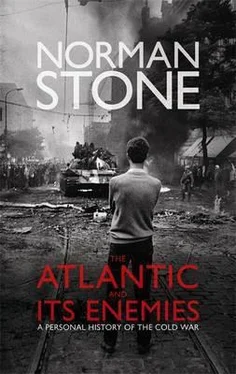Gorbachev himself was not really as revolutionary a figure as these men sometimes claimed. He had climbed the Party ladder from the provinces — Stavropol in the south — as head of personnel in 1963, then, in 1966, as deputy secretary. He did not have foreign languages, but he did have a wife who, as the crack ran, weighed less than himself, and she was educated. His protector, Fyodor Kulakov, regularly met Soviet leaders, such as Suslov and Kosygin, as they came to the Black Sea or the Caucasus on holiday, and that put Gorbachev on their map. In 1978 he went to Moscow as a secretary of department in the Central Committee, with responsibilities of an agricultural nature, but was still quite lucky, in that Kulakov had to take the main responsibility for what went wrong in that domain, and lost his place in 1980 to Gorbachev, who became a full member of the Politburo. It was a meteoric rise. Suslov and later Andropov, for the KGB, bestowed their blessing, and Chernenko even let Gorbachev chair the Politburo in his wheezing absences. Other old men died off — Dmitry Ustinov late in 1984, having run defence for years — or finally just retired, as with the long-term prime minister Nikolay Tikhonov. At any rate, Andropov’s men did emerge in the Politburo by rapid advance, but they, or perhaps their wives, could not compete with Gorbachev. He was sent on a dramatic mission in 1984 to see Margaret Thatcher. The Western Right had recovered, and was prospering; if there was a symbol, it was the re-emergence of England in the first few years of the Thatcher period. She was back on the map again, and was the most obvious place to start if there were a new strategy, of appealing to Washington. That visit was a success. As Margaret Thatcher said, it was not what Gorbachev said: that was wooden language of the old style. It was his eyes. Upon the death of Chernenko, Gorbachev was put forward as general secretary by Gromyko, by now himself aged, who made a remark about his ‘iron teeth’. There was nothing startling about his early pronouncements: ‘we have no need to change our policy. It is correct and truly Leninist. We have to pick up speed and move forward to… our radiant future.’ In his first year he applied himself in the usual way to installing his own men, and in March 1986, when the 27th Party Congress elected the secretariat and the Politburo, half of the members were Gorbachev appointments. Other purgings caused the change of fifty-seven senior functionaries and 40 per cent of the Central Committee members — the second-highest turnover since the death of Stalin. The average age fell to sixty, and by June 1987 two thirds of the government had been replaced. By 1988 25,000 militia-men had been sacked, 1,500 with a conviction, and in Uzbekistan there was an almost complete turnover of the Central Committee.
Someone had said in 1956 that Communism would go on until there was an explosion at the head, in Moscow. By 1980 the empire indeed had its problems, and this time round the United States would not co-operate in keeping it going. The curious thing about this period is Reagan’s perception in 1981 that as regards the USSR the ‘last pages are even now being written’. People ostensibly far better educated took a quite different view — for instance, James Schlesinger and Paul Samuelson, quite apart from the vast majority of sovietologists, who still viewed things through the Vietnam prism. NSD(ecision) D(irective) of March 1982 (repeated in 1983) meant to ‘neutralize’ Soviet control of eastern Europe and there was a deliberate attack on the Soviet economy; in January 1983 the ambition was even to change the USSR fundamentally. This was also a return of the CIA, which had become demoralized in the Carter years, its budget and staff (14,000) run down. Now, with William Casey (who had greatly helped Reagan when, in 1980, the money was running short) and Caspar Weinberger (an old friend of Reagan’s who understood technical advances), there was a change: the cautious East Coast men were sidelined; proper studies of Soviet hard-currency flows and the like were made; and the National Security Council contained allies such as William Clark and Richard Pipes and Admiral John Poindexter (who continued until driven out in 1987 by the Iran-Contra affair). This new team was secretive — Casey flew around in a black plane with living quarters — and only two or three people around Reagan were in the picture: even George Shultz, the Secretary of State, learned of the Strategic Defense Initiative only a few hours before its announcement. Reagan himself hardly bothered with the arms-limitation business that takes such a large place in the works of Don Oberdorfer or Strobe Talbott, and dealt directly with Casey, an old hand from 1941-5, his memories going back to Allen Dulles’s time. Reagan was by now somewhat deaf, and complained that Casey’s voice sounded like a scrambler telephone.
Weinberger’s intention had been to find ways to render Soviet technologies obsolete. There was an especially vulnerable point, the Siberian pipeline. Here was the great legacy of Ostpolitik and détente, a huge project, financed by a foreign and mainly German consortium, that guaranteed the energy supply of central and western Europe; it would give Moscow a vast income and of course leverage in West German affairs. Moscow naturally knew that work on the pipeline could be interrupted through technical or legal obstruction. The Soviets had tried to offset the foreseeable pressure by pinning down work on the Siberian gas pipeline by contract, even to intermediate levels, but had neglected one aspect — the rotor shafts and blades driving the gas turbines for the forty-one compressor stations along the 3,600-mile Urengoy pipeline. General Electric made these, and was now prohibited from providing them. A Soviet team based in Cologne found that a French machinery maker, Alsthom-Atlantique, could make them, even then under a General Electric licence. The government allowed it to act in Moscow.
Meanwhile evidence built up that the Soviets were indeed in economic trouble — the trade surplus of $200m in 1980 had turned into a deficit of $3bn in 1981, and the USSR was having to pick up Polish bills, which weakened its capacity for credits in the West. Gold sales rose from 90 tonnes in 1980 to 240 in 1981, at that with falling prices: a clear sign of trouble. Early in 1982 American agents were sent to Poland through the Israelis, with the Church turning a blind eye: the idea was to co-operate with Solidarność people in hiding. An Israeli contact, manager of a shipyard in Gdańsk, took delivery of equipment for Solidarność, to maintain the pressure from underground, which was smuggled in from Sweden, apparently as tractor parts. Jacek Kuroń sent Reagan a letter from prison to the effect that a mass insurrection could come about: a letter that Reagan kept in his desk. The Warsaw embassy now had a four-man electronics team that could pick up most Polish traffic, and there was, by April, an underground co-ordinating committee which could communicate; there were flurries of activity. There were forays with American diplomats, but it was not the embassy that really mattered: the decoy work was useful.
A continuing point was with the Saudis. Weinberger had Arab friends, particularly Prince Fahd, the apparent heir, whose sons had been educated in England and the USA — a flamboyant spender and gambler, who had apparently opposed the oil price increase in 1973. He saw Saddam Hussein as a help against Iran, the more so as an underground Shiite organization was now active in Bahrain and Saudi Arabia. Weinberger went to Saudi Arabia to work out details, especially for a rapid deployment force that Carter himself had started — with provision for 300,000 US troops. In May 1982 Casey was in Saudi Arabia. The administration had done its best to prevent Congress from revealing the extent of Saudi investment in the USA, at the expense of some bullying by the CIA in Congress. Now, the point was to co-operate against the USSR in oil production — delaying the gas pipeline would contribute — the more so as Soviet oil would displace Saudi in such markets as Belgium. In 1982 Soviet sales to western Europe did increase by about a third and Saudi markets were pressed. Casey and the Saudis did a deal — the US would make things difficult for the USSR (and of course Iran) and the Saudis would do their best to push down prices (in itself this naturally helped the then depressed American economy). Casey also encouraged the Saudis not to use Palestinians, judged unreliable and possibly pro-Soviet; and Fahd wanted to support Islamic movements in Central Asia. Something was done in that direction.
Читать дальше












![Edward Ellis - Adrift on the Pacific - A Boys [sic] Story of the Sea and its Perils](/books/753342/edward-ellis-adrift-on-the-pacific-a-boys-sic-s-thumb.webp)